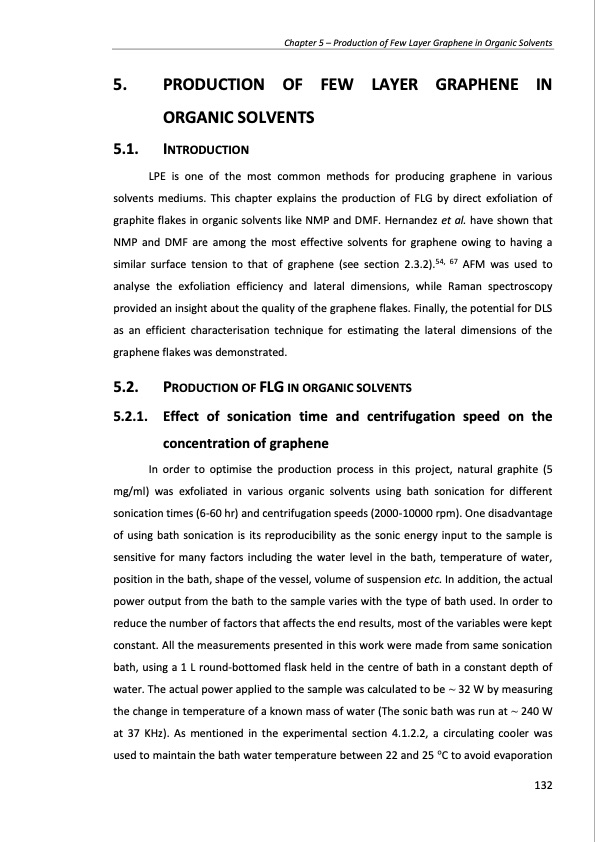
PDF Publication Title:
Text from PDF Page: 132
Chapter 5 – Production of Few Layer Graphene in Organic Solvents 5. PRODUCTION OF FEW LAYER GRAPHENE IN ORGANIC SOLVENTS 5.1. INTRODUCTION LPE is one of the most common methods for producing graphene in various solvents mediums. This chapter explains the production of FLG by direct exfoliation of graphite flakes in organic solvents like NMP and DMF. Hernandez et al. have shown that NMP and DMF are among the most effective solvents for graphene owing to having a similar surface tension to that of graphene (see section 2.3.2).54, 67 AFM was used to analyse the exfoliation efficiency and lateral dimensions, while Raman spectroscopy provided an insight about the quality of the graphene flakes. Finally, the potential for DLS as an efficient characterisation technique for estimating the lateral dimensions of the graphene flakes was demonstrated. 5.2. PRODUCTION OF FLG IN ORGANIC SOLVENTS 5.2.1. Effect of sonication time and centrifugation speed on the concentration of graphene In order to optimise the production process in this project, natural graphite (5 mg/ml) was exfoliated in various organic solvents using bath sonication for different sonication times (6-60 hr) and centrifugation speeds (2000-10000 rpm). One disadvantage of using bath sonication is its reproducibility as the sonic energy input to the sample is sensitive for many factors including the water level in the bath, temperature of water, position in the bath, shape of the vessel, volume of suspension etc. In addition, the actual power output from the bath to the sample varies with the type of bath used. In order to reduce the number of factors that affects the end results, most of the variables were kept constant. All the measurements presented in this work were made from same sonication bath, using a 1 L round-bottomed flask held in the centre of bath in a constant depth of water. The actual power applied to the sample was calculated to be ~ 32 W by measuring the change in temperature of a known mass of water (The sonic bath was run at ~ 240 W at 37 KHz). As mentioned in the experimental section 4.1.2.2, a circulating cooler was used to maintain the bath water temperature between 22 and 25 oC to avoid evaporation 132PDF Image | PRODUCTION AND APPLICATIONS OF GRAPHENE AND ITS COMPOSITES

PDF Search Title:
PRODUCTION AND APPLICATIONS OF GRAPHENE AND ITS COMPOSITESOriginal File Name Searched:
graphene-production-applications.PDFDIY PDF Search: Google It | Yahoo | Bing
Salgenx Redox Flow Battery Technology: Power up your energy storage game with Salgenx Salt Water Battery. With its advanced technology, the flow battery provides reliable, scalable, and sustainable energy storage for utility-scale projects. Upgrade to a Salgenx flow battery today and take control of your energy future.
| CONTACT TEL: 608-238-6001 Email: greg@infinityturbine.com | RSS | AMP |